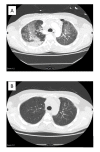Eosinophilic pneumonia associated with bleomycin in a patient with mediastinal seminoma: a case report
- PMID: 20429899
- PMCID: PMC2868877
- DOI: 10.1186/1752-1947-4-126
Eosinophilic pneumonia associated with bleomycin in a patient with mediastinal seminoma: a case report
Abstract
Introduction: Lung toxicities resulting from the chemotherapeutic agent bleomycin encompass a variety of pathological changes, including bronchiolitis obliterans organizing pneumonia, interstitial pneumonitis and progressive interstitial fibrosis. We report a rare case of eosinophilic pneumonia associated with bleomycin.
Case presentation: A 44-year-old Hispanic man with a primary mediastinal seminoma complicated by superior vena cava syndrome underwent treatment with four cycles of bleomycin, etoposide and cisplatin. He had a complete positive response to the chemotherapy. However, three months after treatment he presented with shortness of breath and severe hypoxemia associated with peripheral eosinophilia. Computed tomography showed bilateral diffuse interstitial infiltrates that were refractory to antibiotic treatment. A lung biopsy showed eosinophilic pneumonia. He was subsequently treated with high-dose prednisone, resulting in a complete resolution of his symptoms and lung infiltrates.
Conclusion: This case illustrates that eosinophilic pneumonia may be a late sequela of bleomycin toxicity, and may respond dramatically to steroid treatment.
Figures


Similar articles
-
Pirfenidone as salvage treatment for refractory bleomycin-induced lung injury: a case report of seminoma.BMC Cancer. 2017 Aug 7;17(1):526. doi: 10.1186/s12885-017-3521-0. BMC Cancer. 2017. PMID: 28784103 Free PMC article.
-
Life-threatening bleomycin pulmonary toxicity with ultimate reversibility.Chest. 1990 Aug;98(2):497-9. doi: 10.1378/chest.98.2.497. Chest. 1990. PMID: 1695873
-
Bleomycin-induced pneumonitis in three patients treated with chemotherapy for primary advanced seminoma.J BUON. 2015 May-Jun;20(3):928-32. J BUON. 2015. PMID: 26214649
-
[Consortium for detection and management of lung damage induced by bleomycin].Bull Cancer. 2016 Jul-Aug;103(7-8):651-61. doi: 10.1016/j.bulcan.2016.04.005. Epub 2016 May 27. Bull Cancer. 2016. PMID: 27241272 Review. French.
-
Nodular form of bleomycin-related pulmonary injury in patients with osteogenic sarcoma.Cancer. 1989 Aug 15;64(4):806-11. doi: 10.1002/1097-0142(19890815)64:4<806::aid-cncr2820640407>3.0.co;2-x. Cancer. 1989. PMID: 2472865 Review.
Cited by
-
Meropenem: A possible new culprit in eosinophilic lung diseases.Lung India. 2017 Sep-Oct;34(5):461-464. doi: 10.4103/lungindia.lungindia_328_16. Lung India. 2017. PMID: 28869233 Free PMC article.
References
-
- Bleomycin toxicities. http://www.pneumotox.com
-
- Cooper JA Jr, White DA, Matthay RA. Drug-induced pulmonary disease. Part 1: Cytotoxic drugs. Am Rev Respir Dis. 1986;133(2):321–340. - PubMed
-
- Ginsberg SJ, Comis RL. The pulmonary toxicity of antineoplastic agents. Semin Oncol. 1982;9(1):34–51. - PubMed
LinkOut - more resources
Full Text Sources

